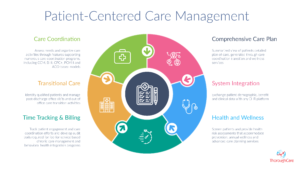
The patient-centric approach involves providing specialized medical services tailored to a patient’s individual values, needs and preferences, along with professional advice and guidance from a healthcare professional. As the name suggests, this means designing a patient-centric process for treatments, clinical trials, or other healthcare services. While it’s more about the mindset of listening to what the patient is thinking and feeling, technologies, tools, and solutions contribute directly to driving this approach and creating a positive healthcare environment. The patient-centred approach is widely recognized by many medical experts as a very qualitative method with positive results from both a medical and business point of view.
From a business perspective, patient-centric healthcare has been reported to have engaging experiences and positive outcomes that lead to patient retention and continuity of care. From a medical perspective, patients respond better to treatments, have fewer symptoms, and are at lower risk of relapse or re-hospitalization. Delivery of Patient-Centric Healthcare For patient-centric providers, tools, and data play an important role. For example, patient-centric practices know that the patient is the only person available for 100% of a person’s care and appointments. The right tools can enable shared decision making, patient feedback loops, and tiered care plans. In addition, the tools must allow the patient to easily access and control their own records while addressing security and trust concerns.
Patient-Centric Strategies

Make these five principles your own! To ensure that the patient is cared for as a substitute for profit, healthcare must include the following:
♣ Ongoing commitment to patients from the beginning
♣ Embedding in the organization
♣ Establishing metrics and accountability where appropriate. it works, it works, or ask patients for feedback,
♣ Be proactive in classifying changing needs in new ways.
♣ Make patients’ voices heard, so they are seen as the primary end-users of the healthcare business.
You may like to read How MRI compatible products are changing the landscape of Healthcare
Advantages
Benefits
A patient-centric approach drives personalized interactions, price transparency, and efficient customer service and can help providers create more targeted and efficient multi-channel marketing campaigns. As a result, healthcare organizations are becoming partners for health and wellness beyond the office. New office tools and alternatives are also being introduced, including things like telemedicine and price comparison tools, adding additional convenience and visibility to the patient experience.
The result? Improved patient-provider relationships foster patient retention and can help differentiate networks from competitors. The main thing here is the connection between medical care and the complexity of the patient’s needs, and the changing requirements are very demanding in the form of a patient/consumer-centric approach, which is always important here as the first thing for the healthcare provider is to consider the patient perspective, regardless of where the company is located.
Overall business priorities and decision-making authority are and must be transparent between the parties to increase patients’ trust in the company. This allows for significant changes in the market related to the healthcare business or the patient’s medical needs, decided only by receiving patient feedback with constant involvement, improving the quality of care and quality of life of healthcare for a strong bond of satisfaction for a “patient-side” Healthcare company.
©2024 Kryptonite SolutionsTM. All Rights Reserved.
Powered by: Purple Tuché